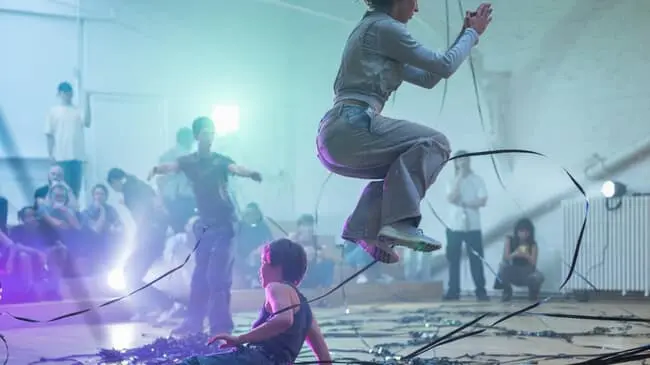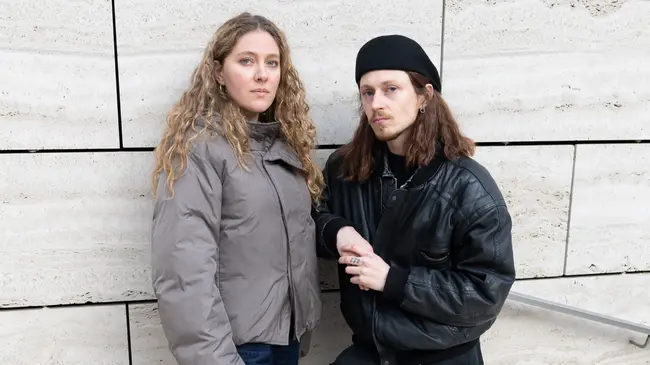Fashion is one of the most important curators of our zeitgeist

MOMU’s reopening welcomed a new exhibition, E/MOTION. Fashion in Transition. The show explores the interaction between fashion and society: the ways in which it represents Emotion and Motion itself, as an ever-changing force within society, both adapting and impacting. Vincent Buyssens, internet culture lecturer and creative digital strategist at Voidwalker, walked through the expo, then reflected on the atmosphere and themes represented in the show, as well as his views on 'motion' and 'emotion' in terms of fashion in a digital age.
What did you think of the layout of the exhibition?
I had already seen the exhibition a few weeks ago at the opening, but I was with other people. Going through it again this time was really nice because I was able to take my time. I got to see the way the exhibition touched upon the most important aspects of the last decades, the elements of what makes a society, like economics, culture, and migration. This is definitely a great extension for the reopening of the museum.
The atmosphere was quite dark, which I appreciated because I like moody spaces
The curation itself was really well done. The atmosphere was quite dark, which I appreciated because I like moody spaces. A show’s atmosphere is very important. Also, the way they integrated video footage with the actual garments was really well done.
Do you think the atmosphere enhanced the theme of Motion and Emotion?
It was definitely not sad or anything, but I think a dark space is a neutral background, on top of which you can build your story. When an atmosphere is very white, it runs the risk of distracting from the stories. So I think it was the right setting for the type of exposition they wanted to do.
There were definitely emotional elements in the show. There was a video on a big screen of a typical dance from the African American community combined with opera. I was transfixed watching it. So they really integrated some cool elements.
There were big screens showcasing the runway shows of Margiela or Walter Van Beirendonck. I think the runway shows are as important as the garments. So I'm happy that they gave emotion a place within the videos.
The expo was separated into different segments, which ones stood out to you?
I really liked how the expo touched upon different topics, so instead of a strictly chronological walk-through of fashion history, the rooms were based on specific topics. One room dove into specific events, like 9/11, Obama talking about the Ebola pandemic, and discussions about the female body and beauty standards. Another room was about migration and different types of cultures.
I really liked how the expo touched upon different topics
I appreciated that there was a segment about cultural appropriation. You cannot do an exposition about fashion without mentioning cultural appropriation, because many of these brands are the biggest offenders. The way I see it, cultural attire only has value in the context that it exists, within that community. If designers just lazily transplant it into a fashion show, without the context, it loses the effect.
Were there any specific pieces that stood out to you?
I really liked the garment from Walter Van Beirendonck. It was a jacket with little pockets, one for your condom, one for your s&m toys, one for your gun.
One of my favourite designers, Rick Owens, also had a really interesting piece. It was a backpack with a model stacked on top of it, which was really on-brand for him. So there were a lot of amazing classical pieces from designers like Margiela, but also from international designers who are not part of the Antwerp Six.
So did you see a lot of diversity in the designers featured in the show?
Definitely, because there were collections from last year, but also some from 1995. There were designers from Antwerp, but also designers from China. There was also a section of the expo focused on migration, which featured some African American designers. This was important for the show because fashion museums should be accessible, so it is important to show the breadth of the fashion industry in order to see how it interacts with society.
What do you think the show said about the role of fashion in social dialogues?
I think fashion is very visible by its nature because it is something that is worn by everybody. Fashion is also something that is discussed a lot, because of the work designers do with models or famous actors, so when a brand does something, it is noticed. Also, even if people don't have much interest in buying certain garments from Margiela or Balenciaga, they might wear a copy of a design sold by a fast-fashion company. Whatever is seen in runway shows, or produced by major fashion houses seeps down into other layers of fashion and consumerism. I think fashion is one of the most important curators of our zeitgeist.
What do you see for the present and future 'Motion' of the fashion industry?
I think now the interaction between fashion and society is happening at an even faster, more intense pace, through social media. Where this interaction used to only occur in the physical space, now we also have the virtual space, and the next step is the metaverse and video games. It’s a never-ending interaction, which is sometimes exhausting, I think.
The next step is the metaverse and video games. It’s a never-ending interaction
There have been a lot of conversations that we’ve seen this past year especially, in which designers have begun to search for ways to bring their garments to the virtual world. I just hope that fashion designers bring the creativity that they've been bringing to our real world and also to the virtual world because there is a void that can be filled by artists bringing their expertise and their vision to the world of video games.
I just hope that fashion designers bring the creativity that they've been bringing to our real world and also to the virtual world
The thing about the virtual worlds of all these video games is that they are separate universes. They have elves and space wizards and all these different things that should trigger designers to create fashion garments for this new space, instead of bringing a fashion garment they created for contemporary Western society or recent audiences and copying it into a virtual world.
Did the show touch upon this topic of virtual worlds involved in the fashion industry?
There was one room that was inspired by virtual worlds. Walter Van Beirendonck actually created virtual characters for his collection. He has always been obsessed with virtual worlds and otherworldly things.
This room really showed the connection between the internet and fashion. It showed this one Versace dress, worn by Jennifer Lopez, that was googled so many times it triggered Google to create Google Images. It really showed the other side of the relationship, how fashion has a tangible effect on the internet as we know it today.
Different Class works with the interest of their community at heart.
Our work’s purpose is to foster a solid network for independent artists, those who love them, and those who want to support them. Become a member to contribute to the local Belgian art scene.





